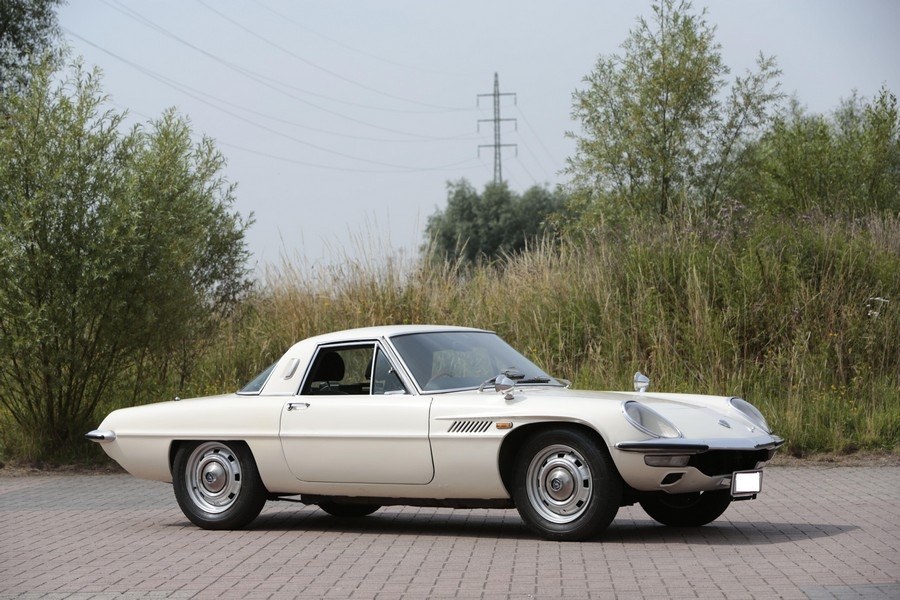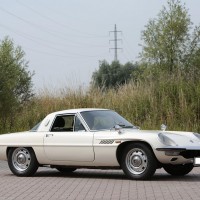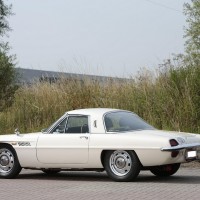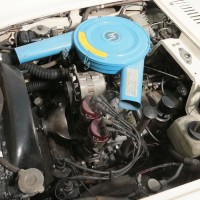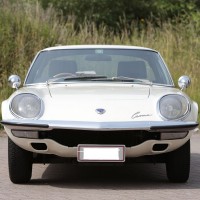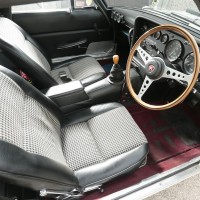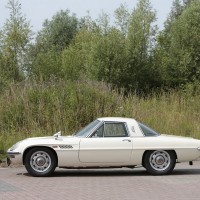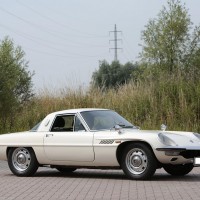SCM Analysis
Detailing
| Vehicle: | 1969 Mazda Cosmo L10B Coupe |
| Number Produced: | 1,519 |
| Original List Price: | $4,390 |
| Tune Up Cost: | $300 |
| Distributor Caps: | $50 |
| Chassis Number Location: | Data plate on center of sheet-metal cross bar at front under hood (Series II); stamped into firewall under hood on left footwell (both SI and SII) |
| Engine Number Location: | Underneath alternator |
| Club Info: | International Cosmo Sport Car Owners Club |
| Website: | http://www.mazdacosmosport.com |
| Investment Grade: | A |
This car, Lot 533, sold for $75,281 (€55,200), including buyer’s premium, at Bonhams’ Les Grandes Marques au Grand Palais sale in Paris on February 6, 2014. (€1.00=$1.363)
I think it is time to end the argument that Japanese vehicles are not interesting enough to enter the collecting mainstream. Even if you put $1m Toyota 2000GTs aside, many of the cars from the fertile imaginations of Japanese auto engineers and the brilliance of the management and marketers — they basically built an industry from the ashes of World War II — are worthy of celebration.
None are more deserving than the groundbreaking and brilliant rotary cars of Mazda. No other company leapt with such bold determination into the brave new world of Dr. Felix Wankel’s fascinating invention. While GM, Daimler-Benz and other big firms played at development and concepts, Mazda was building and selling rotary-powered cars from the top to the bottom of their line.
Rotary with style
Mazda quickly licensed the rotary from NSU in the late 1950s, and then solved important technical issues related to extreme wear in the engine. Then Mazda produced the first two-rotor engine.
By 1964, the two-rotor engine had been tested, and the first car to feature it, the Cosmo Sport, arrived in 1967. That Mazda introduced a full line of rotary-powered cars in 1968 is nothing short of incredible.
To make the impact of this new engine as dramatic as possible, the Cosmo was clothed in sleek bodywork that managed to recall both Italian sports cars and the Ford Thunderbird — without being a copy of anything. It still looks stunning today. When you see one for the first time, you may not be prepared for its size. It is a small, sleek, low missile, ready to rocket forward even when at rest. When launched, it was a bit too small, especially for its target market of Western drivers. After 343 cars were built, a Series II arrived with a longer wheelbase for increased legroom and enhanced ride quality.
Leno loves his Cosmo
The Series II would see an additional 1,519 cars built before the end of production in 1972. These hand-built cars featured a 5-speed gearbox and put out 128 horsepower.
They give a driving experience quite unlike any other sports car. In the words of the old Packard ads, here it pays to “ask the man who owns one.”
In this case, we’ve asked two. Jay Leno collects cars for very specific reasons — and one of the most important reasons is that he wants to drive them. Another reason is that the car has a technology story to tell. The Cosmo scores on both counts.
“The Mazda Cosmo was so ahead of its time, a technologically superior product,” Leno said. “The Wankel was the first new powerplant of the 20th century, and here it is in a clean-sheet, beautiful, hand-built sports car!”
Leno also loves the style of the car, which he describes as a “uniquely Japanese way of looking at the West, capturing the spirit of Beatle haircuts and moon rockets.”
Why wasn’t the Cosmo more of a success? Leno puts it down to the natural proclivity to be suspicious of new technology, which to win the heart has to win the wallet.
“It’s got to be better and cheaper — the Cosmo was far too expensive,” Leno said.
At $4,390 in 1968, the Cosmo certainly was too costly. But it also delivered the goods when it came to performance.
Another Cosmo Sport owner is RM Auctions’ Don Rose. Also the owner of a Toyota 2000GT, Rose found his Cosmo in a Ferrari Market Letter ad. Rose compares the driving experience to that of a small-displacement Alfa Romeo, where you want to keep the revs high to extract the most from the car.
“Below 4,000 rpm there’s not a lot happening, but from there on up, it’s great fun!” Rose said. He also describes the “really smooth, spaceship sounds” the rotary makes while at work.
As Mazda continued development of the twin-rotor engine, it is possible to swap the original Cosmo 10a engine with a later RX-7 12a unit for added power and a wider torque band. This is what Leno has done, and he says the difference is dramatic. Leno kept the original engine in case any future owner should want to return it to stock configuration.
Cosmos not skyrocketing
With the prices of the Toyota 2000GT having passed the $1m mark, why is the Cosmo still so cheap?
First, the 2000GT was sold in much greater numbers in the United States when new. Second, Toyota supported a competition program that showcased the car for a performance-hungry audience.
Very few Cosmo Sports found their way to the U.S., and by all accounts the car was raced only once by Mazda.
We also have not yet seen a superb Cosmo Sport come up for public sale. Our subject car is a nice example, but it is a bit tired. There was some bubbling in the sills, the interior was a bit worn and it had an overall air of fatigue, which is not surprising in a car that has largely been on static display.
There is no doubt that the Cosmo Sport is a very important car and one that will be discovered by a larger audience sooner rather than later, as it truly deserves. The new owner bought this car quite well. ♦
(Introductory description courtesy of Bonhams.)
